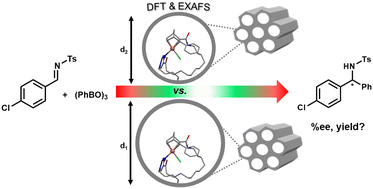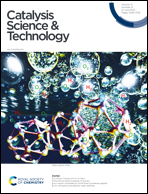Tethering chiral Rh diene complexes inside mesoporous solids: experimental and theoretical study of substituent, pore and linker effects on asymmetric catalysis†‡
Abstract
Understanding confinement effects in molecular heterogeneous catalysis is a challenging task. In a combined experimental and theoretical approach, we studied the influence of the type, polarity, pore size and shape of the mesoporous material as well as of the aryl substituent at the diene, spacer type and lengths on asymmetric Rh diene catalysis under confinement. For this purpose, a library of novel chiral Rh norbornadiene complexes was immobilized on ordered mesoporous silica (OMS), ordered mesoporous carbon (OMC) and non-templated mesoporous SiO2 materials with different pore sizes via azide–alkyne 1,3-dipolar click reaction. Among the different materials, Rh complexes immobilized on OMS performed best in the 1,2-addition of aryl boroxines to N-tosyl imines as a benchmark reaction. High yields were achieved when Rh complexes were connected to pore walls by unbranched linkers of medium lengths (dpore = 5.9 nm). Good enantioselectivities were obtained either by linear alkyl linkers in smaller pores (dpore = 4.9 nm) or branched aminoethanol linkers in larger pores (dpore = 6.8 nm). However, the largest confinement effect was caused by the aryl substituent at the diene moiety, giving up to e.r. 99 : 1 for 1-naphthyl. While complementary X-ray absorption experiments (EXAFS, XANES) could not distinguish between triazole and amide carbonyl coordination at Rh, computational studies supported the triazole coordination.



 Please wait while we load your content...
Please wait while we load your content...